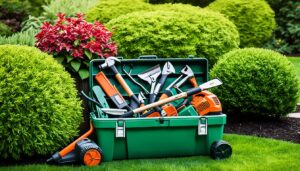After a long hot summer spent enjoying your backyard, you never want to see it come to an end. When the temperatures start to drop and the days get shorter, it is time to start preparing for the fall and winter. Proper prep in the fall can make your work easier in the spring, save your possessions from damage, which in turn will save you money, and also help you be a good neighbour. Here are a few tips for closing up your yard for the season.
Yard Cleanup
For a list of helpful items mentioned in the following sections, see this post
7 Essential Items for Fall Yard Cleanup
Leaf Cleanup
One of the most common fall cleanup jobs is disposing of the fallen leaves. There are many ways to dispose of leaves, depending on what is available in your area. Some areas allow you to simply put your leaves at the side of the street in front of your house, and the city will come along with a vacuum, or front end loader to gather them up. All you have to do is rake, or use a leaf blower to move the leaves to the pickup spot before the collection day and you are all set. A large tarp can help move large amounts of leaves from the back yard to the front all at once. The only real issue with this disposal method is you are subject to the weather conditions, such as high winds that may blow your nicely raked leaves back onto your yard, or your neighbours!
Another popular option is using yard waste bags. These paper bags are available at most home improvement stores and grocery stores. With these you rake the leaves up and put them into the bags, and if your city has yard waste pickup days, the bags will be taken away. Just make sure you check for maximum bags allowed. You can also purchase re-usable bags that you can take to a waste disposal site that accepts yard waste, and empty the bags there and take them back home to be used again. These bags would be a little more expensive up front, but would ultimately save money in the long run. You can also simply transport the paper bags to the disposal sites as well. Some areas allow yard waste drop off free of charge so check your local area.
If you have a pickup truck or a trailer, another option is to simply put the loose leaves into the back of the truck or trailer, cover them securely with a tarp, and transport them in bulk to the disposal site. This would be a lot less time consuming than filling the individual bags, but you want to make sure the leaves are well covered and contained so you don’t leave a trail behind you!
Some other options include using a bagging lawnmower to help with the collection of the leaves for the above disposal methods. It may not get every leaf but it can be a lot less strenuous than raking. For smaller amounts of leaves, you could also use your mower to mulch them and leave them on your lawn to provide nutrients for your grass. If you have a large yard you could also compost the leaves to use for your gardens in the future.
In some more rural areas, burning of leaves may be allowed but make sure you check your local bylaws before doing this.
Plant Cleanup
Another important cleanup job is pruning/cutting back dead plants. For perennials, you want to remove the year’s growth, leaving a bit of the stem to grow again in the spring. You can do this for flowering plants like hydrangea’s, ornamental long grasses, and other flowering plants. For annuals, and things like vegetable gardens, you want to remove any dead plants to make room for planting in the spring.
A good electric hedge trimmer, or some manual snips are best for cutting back plants. To dispose of the pruning’s, you could use any of the options mentioned above for leaf disposal.
Brush Cleanup
If you have any trees that need to be cut back or disposed of, an electric or gas powered chainsaw may be necessary. If you have a wood burning fire place, you may keep any large wood to use for that. For larger trees, or if you use wood for heating regularly, a log splitter might be a good investment, or a good axe if you prefer hard work!
Patio and Deck Cleanup
For a list of helpful items for your patio and deck cleanup, see this post:
5 Items to get your Patio Ready for Winter
Furniture Storage
The area that you live in will determine what precautions you need to take to make sure your patio or deck furniture makes it through the winter. This is one of the most important preparations in terms of saving money, as the better you store your furniture, the longer it will last.
If you have a garage, or shed with room available, either of these would be best to keep everything out of the elements. The only consideration you still need is if these storage areas are creature free as well. Mice and other small rodents love to make nests in pillows and cushions, so if those can be put in bags, or perhaps stored in the house, that will also prolong the life and save you money. Smaller deck boxes could also be used to store a small amount of furniture or cushions.
If you don’t have a garage or shed, the next option is to buy furniture covers. There are many sizes available so you should be able to find the right ones for your furniture. Again, storing any cushions inside would help. If you want to save some money, large tarps and rope or bungy cords work as well as individual furniture covers. Simply move/pile the furniture as best you can, and wrap in a tarp and secure with the rope or bungy cords. It is also a good idea to have a tarp under the furniture, so the legs aren’t sitting directly in the snow/water. You may want to check the tarps throughout the winter to make sure they haven’t moved from the wind or snow.
Gazebos
Another place where I can personally recommend you spend some time prepping for winter is with Gazebos. If you have a fabric roof gazebo, and are subject to large amounts of snow, you will want to take off the top well in advance of the first snowfall. Snow is much heavier than rain, and can rip the top quite easily, or way it down enough to even bend the metal frame.
Metal roof gazebos are much stronger, and should be able to stay up all year, but you might want to double check the snow load rating from the manufacturer. You can also use the gazebo to store your other furniture under to lessen the amount of snow it has to withstand.
Air Conditioner
I have heard different theories around preparing your air conditioner unit for the winter. On one hand, the air conditioner units are built to be outside, so they should be able to withstand the elements. On the other hand, large amounts of ice and snow and freezing and thawing could cause problems and shorten the life of your air conditioning unit. Rust from moisture buildup is also a big problem. So with that being said, some options for preparing your air conditioner could include, simply turning the breaker off to the unit so it can’t be accidentally turned on, purchasing an air conditioner cover or tarp to cover the unit completely, or putting a piece of wood and some weight on top of the unit to keep the leaves and snow out of the fan area, but still allow air flow through to prevent moisture and rust build up. Turning the breaker off is of greater importance when you cover the unit, as if it get turned on, the lack of air flow can cause damage. You may want to consult with your air conditioner maintenance man for their recommendation on the best way to winterize your air conditioner.
Swimming Pools
In my opinion, closing a pool for the winter is best done by the professionals. You need to remove all water from the system to prevent it from freezing and causing damage to underground pipes and equipment such as pumps and heaters. Cracks in pipes and leaks can be hard to find and very expensive to fix. Pumps and heaters can be very expensive to replace as well, so paying someone to protect these will definitely pay off in the long run.
Ponds and Water Features
Depending on the size and depth of the pond or water feature, they may need similar preparations for winter as a swimming pool. You need to remove the pump and hose from the water, and make sure the hose is empty so if the water freezes, it won’t damage anything. If you have fish in your pond, you may want to get an indoor aquarium for them to live in during the winter, or if your pond is deep enough to not freeze completely, you can get a bubbler pump that simply has a tube that blows air into the water to give it oxygen for the fish. Again, if you have expensive fish, you may want to spend the extra for the aquarium to give them a much better chance at survival.
Summary
Over the years of owning my home, I have learned the hard way that poor preparation for the winter can be expensive. I have gone through countless gazebos, that if I had invested up front for a good metal roof one, I would still be ahead of the game. Also, improper storage of our furniture has resulted in rust damage and a lot of replaced chairs. Hopefully you all can benefit from my experiences and not have to go through them all yourselves.
Make sure you check back often for more helpful tips.







